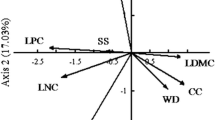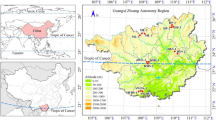Abstract
The diversity of tropical dry forests is poorly described and their regeneration ecology not well understood, however they are under severe threat of conversion and degradation. The Hellshire Hills constitute a dry limestone forest reserve on the south coast of Jamaica that is of high conservation value. In order to describe the structure and composition of this forest and assess the extent to which the population structures of its tree species do characterize their regeneration ecologies, pre-disturbance structure, floristics and seedling populations were compared with post-disturbance species responses in twelve 15 m × 15 m permanent sample plots which were laid out in a blocked design in April 1998, giving a total sample area of 0.27 ha. These plots were subjected to disturbance in April 1999 (cutting) with each of four blocks being assigned with two randomly allocated treatment plots (partially and clear cut) and one control plot (uncut). A total of 1278 trees (≥2 cm DBH) and 7863 seedlings and saplings (0–2 mm and 2–20 mm root collar diameter (RCD) respectively), comprising 60 and 52 species, respectively, were sampled in the plots prior to disturbance. The species-area curve for trees reached a maximum at 0.20 ha, and abundance was widely distributed amongst the species (26 had importance values greater than 1%); four species were notably codominant (with importance values between 7 and 8%). The forest stand structure had a reverse J-shaped curve for tree and for seedling/sapling size-class distributions, which indicated that the forest as a whole was probably regenerating adequately. From an analysis based on adult and sapling size-class distributions (SCDs), 21 species with 15 or more individuals were classified into 3 groups. Many of the species (15 of the 21), had flat adult SCDs that deviate from the whole-community reverse J-shaped SCD. However, sapling SCDs for 6 of the 15 species were strongly positive indicating the potential for their populations to be sustained by recruitment from the saplings present. No general association was found between these SCD species groupings and the actual ability of the species to recover from disturbance. Analysis of post-disturbance response revealed that for only 9 of the 21 species did adult SCDs provide adequate prediction, but for an additional 6 of the species information on sapling SCDs improved the accuracy of prediction if the ‘release’ of saplings or smaller individuals predominated recovery. However in this forest, recovery following disturbance which left stem and roots in place is predominantly by coppice regrowth, and there were no significant correlations found between adult SCDs and the species’ ability to coppice.
Similar content being viewed by others
References
C.D. Adams (1972) Flowering Plants of Jamaica University of West Indies Mona, Jamaica
C.D. Adams M.C. du Quesnay (1970) Vegetation J.D. Woodley (Eds) Hellshire Hills Scientific Survey University of the West Indies Mona 49–119
J.S. Beard (1944) ArticleTitleClimax vegetation in Tropical America Ecology 25 127–158
J.S. Beard (1955) ArticleTitleThe classification of Tropical American vegetation-types Ecology 36 89–100
A. Borhidi (1987) ArticleTitleThe main vegetation units of Cuba Acta Bot. Hung. 33 151–185
D.G. Campbell (1989) Floristic inventory of tropical forests D.G. Campbell H.D. Hammond (Eds) Floristic Inventory of Tropical Countries New York Botanical Garden New York 523–533
R. Condit R. Sukumar S.P. Hubbell R.B. Foster (1998) ArticleTitlePredicting population trends from size distributions a direct test in a tropical tree community Am. Nat. 152 494–509 Occurrence Handle10.1086/286186
J.T. Curtis R.P. McIntosh (1951) ArticleTitleAn upland forest continuum in the prairie-forest border region of Wisconsin Ecology 32 476–496
A.H. Gentry (1995) Diversity and floristic composition of neotropical dry forests S.H. Bullock H.A. Mooney E. Medina (Eds) Seasonally Dry Tropical Forests Cambridge University Press Cambridge 146–194
K. Gerhardt H. Hytteborn (1992) ArticleTitleNatural dynamics and regeneration methods in tropical dry forests – an introduction J. Veg. Sci. 4 95–102
T.W. Gillespie A. Grijalva C.N. Farris (2000) ArticleTitleDiversity, composition and structure of tropical dry forests in Central America Plant Ecol. 147 37–47 Occurrence Handle10.1023/A:1009848525399
O.J. Gonzalez D.R. Zak (1996) ArticleTitleTropical dry forests of St. LuciaWest Indies: vegetation and soil properties Biotropica 28 618–626
K.A. Gould T.S. Fredericksen F. Morales D. Kennard F.E. Putz B. Mostacedo M. Toledo (2002) ArticleTitlePost-fire tree regeneration in lowland Bolivia: implications for fire management For. Ecol. Manage. 165 225–234 Occurrence Handle10.1016/S0378-1127(01)00620-X
L.R. Holdridge W.C. Grenke W.H. Hatheway T. Liang J.A. Tosi SuffixJr. (1971) Forest Environments in Tropical Life Zones: A Pilot Study Pergamon Press Oxford
D.H. Janzen (1988a) ArticleTitleManagement of habitat fragments in a tropical dry forest: growth Ann. Mo. Bot. Gard. 75 105–116
D.H. Janzen (1988b) Tropical dry forests: the most endangered major tropical ecosystem E.O. Wilson (Eds) Biodiversity National Academy Press Washington, DC 130–137
V. Kapos (1986) Dry limestone forests of Jamaica D.A. Thompson P.K. Bretting M. Humphreys (Eds) Forests of Jamaica The Jamaican Society of Scientists and technologists Kingston, Jamaica 49–58
C.K. Kelly M.G. Bowler (2002) ArticleTitleCoexistence and relative abundance in forest trees Nature 417 437–440
D.L. Kelly E.V.J. Tanner V. Kapos T.A. Dickinson G.A. Goodfriend P. Fairbairn (1988) ArticleTitleJamaica limestone forests: floristics, structure and environment of three examples along a rainfall gradient J. Trop. Ecol. 4 121–156
D.K. Kennard (2002) ArticleTitleSecondary forest succession in a tropical dry forest: patterns of development across a 50-year chronosequence in lowland Bolivia J. Trop. Ecol. 18 53–66 Occurrence Handle10.1017/S0266467402002031
D.K. Kennard K. Gould F.E. Putz T.S. Fredericksen F. Morales (2002) ArticleTitleEffects of disturbance intensity on regeneration mechanisms in a tropical dry forest For. Ecol. Manage. 162 197–208 Occurrence Handle10.1016/S0378-1127(01)00506-0
D. Lieberman M. Li (1992) ArticleTitleSeedling recruitment patterns in a tropical dry forest in Ghana J. Veg. Sci. 3 375–382
E.J. Lott S.H. Bullock J.A. Solis-Magallanes (1987) ArticleTitleFloristic diversity and structure of Upland and Arroyo Forests of Coastal Jalisco Biotropica 19 228–235
A.M. Lykke (1998) ArticleTitleAssessment of species composition and change in savanna vegetation by means of woody plants’ size class distributions and local information Biodiv. Conserv. 7 1261–1275
K.P. McLaren (2001) The Regeneration of a Jamaican Dry Limestone Forest After Different Intensities of Human Disturbance University of Wales BangorWales, UK 249
K.P. McLaren M.A. McDonald (2003a) ArticleTitleCoppice regrowth in a disturbed tropical dry limestone forest in Jamaica For. Ecol. Manage. 180 99–111 Occurrence Handle10.1016/S0378-1127(02)00606-0
K.P McLaren M.A. McDonald (2003b) ArticleTitleSeedling dynamics after different intensities of human disturbance. in a tropical dry limestone forest in Jamaica J. Trop. Ecol. 19 567–578 Occurrence Handle10.1017/S0266467403003626
McLaren K.P. and McDonald M.A. 2005. Patterns of seed production and seed rain within artificially disturbed sites in a tropical dry forest in Jamaica. Biotropica. (in press)
P.M. Miller (1999) ArticleTitleCoppice shoot and foliar crown growth after disturbance of a tropical deciduous forest in Mexico For. Ecol. Manage. 116 163–173 Occurrence Handle10.1016/S0378-1127(98)00450-2
P.M. Miller J.B. Kauffman (1998) ArticleTitleSeedling and sprout response to slash and burn agriculture in a tropical Deciduous forest Biotropica 30 538–546
P.G. Murphy A.E. Lugo A.J. Murphy (1983) ArticleTitleSeasonal dynamics and recovery of a Caribbean dry forest Bull. Ecol. Soc. Am. 64 113
P.G. Murphy A.E. Lugo (1986a) ArticleTitleEcology of tropical dry forest Ann. Rev. Ecol. Syst. 17 67–88 Occurrence Handle10.1146/annurev.es.17.110186.000435
P.G. Murphy A.E. Lugo (1986b) ArticleTitleStructure and biomass of a subtropical dry forest in Puerto Rico Biotropica 18 89–89
P. Negreros-Castillo C. Mize (1993) ArticleTitleEffects of partial overstorey removal on the natural regeneration of a tropical forest in Quintana RooMexico For. Ecol. Manage. 58 259–272 Occurrence Handle10.1016/0378-1127(93)90149-H
J. Obiri M. Lawes M. Mukolwe (2002) ArticleTitleThe dynamics and sustainable use of high value tree species of the coastal Pondoland forests of the Eastern Cape ProvinceSouth Africa For. Ecol. Manage. 166 131–148 Occurrence Handle10.1016/S0378-1127(01)00665-X
J.P. Pascal R. Pelissier (1996) ArticleTitleStructure and floristic composition of a tropical evergreen forest in South–West India J. Trop. Ecol. 12 191–214 Occurrence Handle10.1017/S026646740000941X
M.S. Ross J.J. O’Brien L.J. Flynn (1992) ArticleTitleEcological site classification of Florida Keys terrestrial habitats Biotropica 24 488–502
J. Russell-Smith (1996) ArticleTitleRegeneration of monsoon rain forest in Northern Australia: the sapling bank J. Veg. Sci. 7 889–900
C. Sabogal (1992) ArticleTitleRegeneration of tropical dry forests in Central Americawith examples from Nicaragua J. Veg. Sci. 3 407–416
I.K. Smith J.L. Vankat (1992) ArticleTitleDry evergreen forest (coppice) communities of North Andros IslandBahamas Bull. Torrey Bot. Club 119 181–191
R.W. Sussman A. Rakotozafy (1994) ArticleTitlePlant diversity and structural analysis of a tropical dry forest in Southwestern Madagascar Biotropica 26 241–254
M.D. Swaine (1992) ArticleTitleCharacteristics of dry forest in west Africa and the influence of fire J. Veg. Sci. 3 365–374
M.D. Swaine D. Lieberman J.B. Hall (1990) ArticleTitleStructure and dynamics of a tropical dry forest in Ghana Vegetatio 88 31–51 Occurrence Handle10.1007/BF00032601
P. Vogel R. Nelson R. Kerr (1995) Conservation strategy for the Jamaican iguanaCyclura collie. Contributions to West Indian Herpetology: a Tribute to Albert Schwartz R. Powell R.W. Henderson (Eds) Contributions to Herpetology, Vol. 12 Society for the Study of Amphibians and Reptiles IthacaNew York 1–12
D.F. Whigham P. Zugasty Towle E. Cabrera Cano J. O’Neill E. Ley (1990) ArticleTitleThe effect of annual variation in precipitation on growth and litter production in a tropical dry forest in the Yucatan of Mexico Trop. Ecol. 31 23–34
Author information
Authors and Affiliations
Corresponding author
Rights and permissions
About this article
Cite this article
McLaren, K.P., McDonald, M.A., Hall, J.B. et al. Predicting Species Response to Disturbance from Size Class Distributions of Adults and Saplings in a Jamaican Tropical Dry Forest. Plant Ecol 181, 69–84 (2005). https://doi.org/10.1007/s11258-005-3497-8
Received:
Accepted:
Issue Date:
DOI: https://doi.org/10.1007/s11258-005-3497-8




